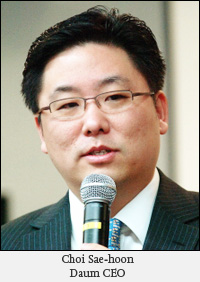
Daum’s dilemma
Why is portal site always second to Naver?
 Ironically, Web portal Daum, meaning “next” in Korean, has been second in line behind domestic rival Naver throughout the last decade.
Ironically, Web portal Daum, meaning “next” in Korean, has been second in line behind domestic rival Naver throughout the last decade.
The last time, and with all probability the only time, it was undisputed top-dog of the Korean Internet market was when it was founded in 1995 and saw a spectacular rise from then on.
When information technology was bustling here with strong backing from the government to become one of the most wired countries in the world, Daum Communications offered the first free domestic email service in 1997, and launched its Web portal and still popular Internet forum Daum Cafe in 1999.
Since then, the pioneer of the domestic Internet community has always been a runner-up to Naver. Public views of Daum and its anxiety in recent years were well expressed in an incident in November.
When Eric Schmidt, then Google’s chief executive, visited Korea to talk with policymakers and company CEOs, speculation rose that Daum Communications’ founder and major stockholder Lee Jae-woong was among the people he would visit.
There were rumors that the two were planning talks on Google’s purchase of Daum. Lee strongly denied the rumors via Twitter, and slammed media outlets and reporters asserting it was careless fact checking. Nonetheless, Daum’s reputation as an “affordable company” due to various investment firms holding its shares was unbecoming of the first domestic Internet business to be listed on the KOSDAQ.
“There was some cooperation between Google and Daum in the past, and that was the reason for the rumor,” said Thomas Kang, a research director at Strategy Analytics. “Lee Jae-woong’s strong denial can be seen as a strategy to avoid losing consumers, who are usually not positive on mergers and if they happen, leave to look for other providers of the same service.”

Daum, cornered by Naver in Web services and Google in the recently rising mobile market, is desperate to diversify its portfolio and find a niche amid the monopoly of its two rivals. It has ventured into television and released Daum TV this month, which has received negative reviews by consumers.
“Daum and Naver started similarly, both with their own strengths and weaknesses. Daum had more users thanks to its email and forum services. But Naver started an auction system for its advertisements, which allowed companies to post their commercials in designated locations for maximum exposure for the right price,” said Kang.
“The strategy differentiated Naver from Daum, and advertisement companies flocked to Naver which provided it with vast funds that eventually allowed it to equalize in forum services and develop blogs against Daum.”
The vast funds also allowed Naver to invest in its brand. Daum reinforced its services against the rise of Naver, but eventually lost in
marketing due to the vast difference in capital.
In statistics released by Nielsen KoreaClick, Daum marked 27.69 million unique visitors in March, behind Naver’s 30.88 million. The number of visitors has remained more or less in the 27 million range during the past five years since 2007, around the time Naver cemented its position as the No.1 search engine.
According to its own survey, Daum posted a net profit of 418 billion won in 2011, a rise from 345 billion won in 2010 and 244 billion won in 2009. But Naver secured 2.1 trillion won for 2011, near five-fold Daum’s profit for the same year.
Besides marketing, another Seoul-based analyst, who requested anonymity, pointed out that Daum made some investment choices that were in retrospect perhaps “too ahead of their time.”
In 2006, when Daum, Naver and Yahoo Korea were competing for supremacy, the two domestic competitors took very different roads to gather more users. According to the analyst, Daum, rightly expecting a rise in video and animation content that are now widespread, invested heavily in the sector. Naver focused on enhancing search services and created Naver Knowledge-iN, which allows users to post information concerning any topic, much like Wikipedia.
“The thing about the Internet market is (its) unpredictability,” said the analyst. “Knowledge-iN was the last draw that put Naver ahead of Daum and every other domestic contender. Though the judgment is in hindsight, Daum chose the wrong market to invest in.”
Daum, not relenting in the competition, released a map service in 2009 that gave it brief momentum. Naver promptly released a similar service and thanks to its strong brand image, redirected users of Daum to its own product.
But the future is not all gloom and doom for Daum, and they still have a chance to make headway in the mobile sector.
“The focus is now on combining Internet and mobile platforms. Though the sector is dominated by Naver and Google, the fight has only just begun. Repeated failures eventually lead to success, so if there is chance for Daum, it is mobile businesses,” said Kang. <Korea Times/Cho Mu-hyun>


